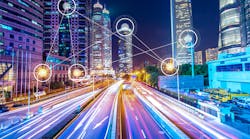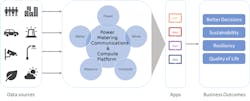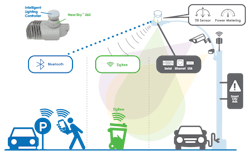Smart Utilities are Stepping Up to the New Smart Cities Business Opportunity
Cities are home to more than half of the world’s population -- and they are expected to add another 2.5 billion new residents over the next 30 years. In anticipation of this growth, cities are turning to smart city applications to improve city operations, the quality of life for city inhabitants and to foster economic development.
For anyone new to smart cities, a smart city uses information and communications technology (ICT) to enhance its livability, workability and sustainability. In the simplest terms, there are three parts to that job: ‘collecting’, ‘communicating’ and ‘crunching’:
- First, a smart city collects information about itself through sensors and other devices such as controls and existing systems.
- Second, a smart city communicates that data – whether by using wired or wireless networks.
- Third, a smart city ‘crunches’ (i.e., analyzes) that data in order to understand what’s happening now and what’s likely to happen in the future. Cloud-based and mobile applications then present these analyses to those individuals who can best act on it.
Smart cities are being defined as those cities which are utilizing operational technologies (OT) and ICT, with the aim to increase the quality of life of city inhabitants while also enabling more sustainable development. The term ‘smart cities’ is, of course, a broad concept; the realization of that concept for each city is as unique as that city itself.
Most cities are still in the evaluation or “innovator/early adopter” stage of adoption and often struggle to fully understand the many products and technologies that make up something that might be called the “smart city ecosystem”. Despite that, what some are calling the “smart cities movement” is real, with local and global initiatives focused on transforming cities into more livable, workable and sustainable urban areas. To carry out these initiatives, cities are tapping into old urban infrastructures, legacy IT systems, public data sources and instrumenting their diverse, outdoor physical assets with sensors, instruments and controls.
By embedding intelligence into assets of all kinds, the objective is to monitor and liberate previously unavailable data from across the urban landscape. The hope is to use data to improve real time situational awareness; then, cities can utilize that aggregated data to drive efficiencies and improve asset performance.
Smart and connected digital lighting is being hailed as the first ‘Killer Application’ in the smart city domain. Important breakthroughs in lighting technology, as deployed during the last decade, are driving replacement of the entire public lighting fleet worldwide. Light Emitting Diode (LED) technology now exceeds the efficiency and reliability of traditional legacy sodium and mercury public lighting. LEDs are manufactured on semiconductor production lines, driving down cost and increasing performance in the same way that computer chips have evolved. LEDs are less complex to manufacture and operate and are more controllable than glass bulbs containing high-pressure or low-pressure gas. LEDs can also be factory-tuned to present pleasing, people-friendly light, whereas gas bulbs typically emit only a few narrow bands of light resulting in an unnatural orange or ghostly white landscape.
Outdoor LED lighting provides an easy, cost effective way for cities to begin their smart city initiatives. By adding intelligent controls, cities and utilities can realize significant energy savings and better asset management of the lighting infrastructure. Roadway and street lights, often owned by utilities, are the ideal starting point in creating a smarter city:
-Roadway and street lights are ubiquitous where people live and work, and conveniently distributed throughout the city.
-Wireless lighting controls are easily installed on existing street light poles, thus avoiding trenching or construction costs.
The key benefits of using LEDs, digital controls and central management system software are these:
- Lower cost, short ROI
- Faster to commission
- Simpler to operate
- Immediate savings by reducing energy, operating and maintenance costs
- Enabling better operational decisions by the rank and file city workforce or utilities
According to the Energy Information Agency of the U.S. Department of Energy, upgrading to LED luminaires can result in energy savings averaging 50%. Adding digital controls, to dim and brighten the lights based upon conditions, can deliver another 10-20% energy savings. Real-time monitoring of the operations and diagnostic health of the lighting infrastructure can produce significant savings in maintenance, repair and operational costs. Better asset management of outdoor lighting can drive efficiencies, in some cases up to 50%.
Street light poles are an increasingly valuable piece of vertical real estate, there to be monetized by the pole owner (be it a city, utility or telco). The owner can charge pole attachment and other fees for hosting Smart City applications like sensor platforms, video surveillance, digital signage, small cells and other services sited on street light poles. Monetization of these smart city applications is accomplished via emerging Machine to Machine (M2M) and Internet of Things (IOT) technologies, where metered power, edge processing, and data communications are available through smart data hubs mounted on the Smart Lighting.
Utilities are emerging as key partners in the drive towards a smarter city. Utilities own significant relevant assets, and as incumbent network operators, can be well-positioned to realize better returns from deployed assets and their operational capabilities such as:
- Retrofitting lighting infrastructure with LED luminaires fitted with smart controls.
- Running multiple applications on the utility smart grid (AMI) network.
- Leveraging utility assets to enable non-energy initiatives.
- Capitalizing pole ownership rights to expand into new areas of business such as in unregulated markets.
- Leveraging digital street light infrastructure to monetize other applications.
The realization of smart cities will require entirely innovative approaches to age old municipal issues. Innovative technology, talent, collaboration and financing models will unite stakeholders like never before. The key stakeholders are the cities themselves, utilities, technology companies, infrastructure providers, funding sources and the like. Smart and connected devices deployed across the urban landscape can liberate data from urban and utility assets. The collected data feeds into cloud based and mobile applications to create safer, more livable cities, while enabling the delivery of better services to citizens.
Machine to Machine (M2M) technologies, Internet of Things (IoT) technologies, and ICT are each increasingly being applied to improve operational efficiencies inside complex organizations like cities and utilities, and to improve quality of life in public spaces. Some of these qualities are public safety, situational awareness, environmental protection, detection of airborne hazards, identification of suspicious activity, robust post-incident forensics, and more.
As the utility-owned lighting fleets are refreshed, utilities have additional opportunities to install systems that increase the utilization of their public infrastructure. The savings provided by LED technology can help to fund these improvements.
Since many city and utility assets are located outdoors and are expected to have useful lives of up to 20 years, smart city enabling technologies must meet the following criteria:
1. Value Today and Tomorrow - provide products and services to customers that deliver measurable value, including lower energy, repairs and maintenance costs, higher quality of services and ancillary benefits such as reduced crime and higher property values, and platforms to create connected city applications.
2. Network Independence – create solutions that work in multiple network environments.
3. Modular– protect today’s investments while building “plug & play” modules that are compatible with existing installations and provide new features and benefits.
4. Open Architecture/APIs - enable third-party, “best-in-class” solutions to join the street lighting network and take advantage of an extensive development community and wide variety of sensors and other devices.
According to one study recently produced by the McKinsey Global Institute, smart city applications could:
- Reduce fatalities by 8–10%
- Accelerate emergency response times by 20–35%
- Shave the average commute by 15–20%
- Lower the disease burden by 8–15%
- Cut greenhouse gas emissions by 10–15%
Unfortunately, most of the current technologies and systems that aim to address these qualities are siloed solutions, with unique installation procedures, and with separate power supplies, software, monitoring practices, utility tariff issues, and billing practices.
A simpler and more flexible approach is illustrated in the following graphic.
Is it possible for smart cities and smart utilities to transition, in one step, from solutions focused on the city streetscape to what might be called the 'smart-scape'?
Cimcon, a U.S.-based innovations company that is financed by a group of 12 U.S.-based utilities, developed the NearSky Smart City Platform to transform existing street light infrastructure into a robust Internet of Outdoor Things for smart city devices and services. It seems to be working quite well for a growing number of cities around the world.
The plug-and play installation of what Cimcon calls “NearSky 360 Edge” on luminaires enables the city to complete various tasks with relative ease: capturing, analyzing, aggregating and communicating data from a wide variety of outdoor, urban sensors. Cimcon’s NearSky 360 provides the power, processing, communications and power metering (for utility billing) to deploy and manage devices that improve city operations, save energy, protect the environment, increase public safety and enhance the quality of daily life.
Stand-alone sensor platforms can be complex and costly to install, and positioning is sometimes a challenge. Because Cimcon’s solution is mounted on the city’s street lights, it has access to power and can be located virtually everywhere. In addition, NearSky 360 connects to the existing NEMA socket, making it exceptionally easy to remove from one fixture and reinstall at another location. One city official -- from a major US city in the Midwest -- reported that the city is constantly moving their video surveillance cameras, each move requiring an electrician and other contractors. A solution such as NearSky360 simplifies -- thereby reducing the cost of every reinstallation.
NearSky 360 is a unique “fog computing” or “edge processing” device optimized for mounting on the photocell socket of an outdoor light fixture. It consists of a microcontroller that can host a wide variety of Linux-based applications utilizing external data from wired, wireless, and video inputs which in turn can be used to enhance safety, reduce costs, increase revenues, and improve quality of life within a city or town.
NearSky 360 has the potential to bring the Internet of Outdoor Things within reach for cities. Since NearSky 360 deploys on existing infrastructure, it can be positioned where it’s needed quickly and easily. The transportable units provide robust capacity to enable a broad range of sensor technologies on or near the pole. These services can be moved or added as services expand or needs change. NearSky™360 offers network flexibility as well. It’s compatible with a broad range of citywide and smart grid networks such as cellular, ZigBee, Cisco, Itron, Trilliant, Ingenu RPMA and LoraWAN. CIMCON is the leading manufacturer of outdoor networked wireless lighting controls that offers an easy path to future smart city applications combined with a smart cities platform specifically designed to be powered by and deployed using existing street lights.
A continuously expanding array of smart city applications will enable municipalities to reduce costs, generate new revenue streams, enhance security, and improve services to residents, tourists, and businesses. NearSky™ Smart City Platform puts the process on the fast track to the future with a sturdy, scalable backbone to collect and manage data at any NearSky 360 equipped streetlight.





